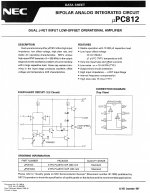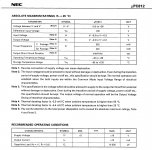Hello everyone,
New member here. Hope that I posted into the right forum, if not-my apologues.
I have a Nakamichi CA-7A preamp that uses NEC ICs, MuPC812C. The preamp works and sounds great. HOWEVER, this IC is at least 20 years old and I think that it could be substituted with modern opamps(s) leading to sound improvement.
According to the datasheet the muPC812 is a dual J-FET input low-offset opamp.
There are three of them in each channel of the CA-7A, two in the phono preamp and one in the line stage.
Any thoughts what might be a good substitution?
First three pages of the MuPC812 datasheet are attached. The CA-7A amp schematics is attached in the next post.
Thank you.
New member here. Hope that I posted into the right forum, if not-my apologues.
I have a Nakamichi CA-7A preamp that uses NEC ICs, MuPC812C. The preamp works and sounds great. HOWEVER, this IC is at least 20 years old and I think that it could be substituted with modern opamps(s) leading to sound improvement.
According to the datasheet the muPC812 is a dual J-FET input low-offset opamp.
There are three of them in each channel of the CA-7A, two in the phono preamp and one in the line stage.
Any thoughts what might be a good substitution?
First three pages of the MuPC812 datasheet are attached. The CA-7A amp schematics is attached in the next post.
Thank you.
Attachments
I've never heard of that device...
However looking at the circuit shows that all these are configured as DC servos and so they are not in the audio chain as such.
They are used to reduce the DC offset of each (discrete component) stage to zero volts. The opamps are configured as integrators (to remove all audio) and leave an "average" DC bias voltage to apply to the real audio circuitry.
These days a typical servo would use a device such as the cheap and common TL072 opamp. What is important for a servo is that it must be FET device with low input bias currents.
You won't gain anything replacing them and looking at the power supply, one of them is shown as fed via zeners only, and from a higher (-/+33v) voltage supply. No power supply decoupling is shown for that IC and so replacing with anything other than the specified part could even cause a problem (instability).
However looking at the circuit shows that all these are configured as DC servos and so they are not in the audio chain as such.
They are used to reduce the DC offset of each (discrete component) stage to zero volts. The opamps are configured as integrators (to remove all audio) and leave an "average" DC bias voltage to apply to the real audio circuitry.
These days a typical servo would use a device such as the cheap and common TL072 opamp. What is important for a servo is that it must be FET device with low input bias currents.
You won't gain anything replacing them and looking at the power supply, one of them is shown as fed via zeners only, and from a higher (-/+33v) voltage supply. No power supply decoupling is shown for that IC and so replacing with anything other than the specified part could even cause a problem (instability).
Thank you Mooly,
I wouldn't change these ICs.
Interestingly, this preamp looks to be designed in such a way that one can't upgrade it much by substituting components. Resistors are metal film, capacitors are polystyrene, no electrolytic cap in the amp section. The only thing I found upgradeable are pots- they are half-turn and too "touchy".
I wouldn't change these ICs.
Interestingly, this preamp looks to be designed in such a way that one can't upgrade it much by substituting components. Resistors are metal film, capacitors are polystyrene, no electrolytic cap in the amp section. The only thing I found upgradeable are pots- they are half-turn and too "touchy".
- Status
- Not open for further replies.



